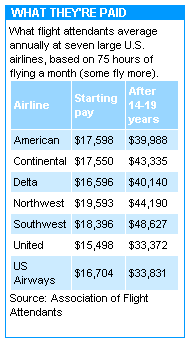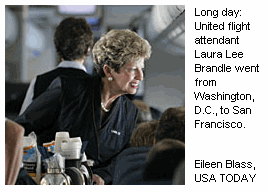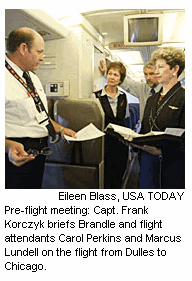Jumpseatnews.com - United Airlines flight attendant resources
Flight Attendants' Responsibilities Grow with Changes in Industry
Source: USA Today
Author: Kitty Bean Yancey
Skies are unfriendlier, but the smiles remain
DULLES, Va. — When Laura Brandle dropped out of Oklahoma State University to fly with United Airlines in 1967, the job of stewardess was the carefree, glamorous career that girls dreamed about.
 In a blue hat and white gloves, she glided through the cabin on required 3-inch heels, encased in a mandatory girdle, serving martinis to cigar-puffing men in suits and dispensing the "miles of smiles" taught in training.
In a blue hat and white gloves, she glided through the cabin on required 3-inch heels, encased in a mandatory girdle, serving martinis to cigar-puffing men in suits and dispensing the "miles of smiles" taught in training.
On a September morning 38 years later, that smile is still as lustrous as the pearls around her neck as she greets casually dressed passengers boarding Flight 851 from Dulles International Airport to Chicago's O'Hare. Though seeming just to be saying pleasant hellos, she's really scanning each passenger's face for signs of trouble.
As the three undercover sky marshals positioned around the cabin attest, the skies have become a lot less friendly since the attacks of Sept. 11, 2001. And the job of flight attendants is far grimmer in these days of security checks, airline budget cuts, bankruptcies and packed cattle-car economy cabins.
"There's a lot on flight attendants' minds today," Brandle says. "There have been pay cuts. Our duties are more. We are struggling to hold on to what we've worked for so many years to attain. And we are the watchdogs: We must suspect everybody and everything and keep our antennae up."
 The image of flight attendants also is less glamorous in an era when some passengers regard them as flying waitresses and waiters, dowdier and grumpier than the old-time "stews." Even movie depictions aren't flattering: Flight attendants' unions have called for a boycott of the hit Jodie Foster film Flightplan, saying it inaccurately portrays cabin crews as uncaring, even malevolent.
The image of flight attendants also is less glamorous in an era when some passengers regard them as flying waitresses and waiters, dowdier and grumpier than the old-time "stews." Even movie depictions aren't flattering: Flight attendants' unions have called for a boycott of the hit Jodie Foster film Flightplan, saying it inaccurately portrays cabin crews as uncaring, even malevolent.
This year marks the 75th anniversary of the first stewardess taking to the skies for the airline that eventually became United. Yes, the job has changed, Brandle says. But with flight crews' role in deterring terrorism now a priority, "We've gotten a little more respect."
To show the realities of a modern-day flight attendant's life, Brandle has agreed to be shadowed on a workday. It will take her from her home airport, Dulles, outside Washington, D.C., to Chicago, then on to San Francisco for a layover.
The first flight
Here's how her 16-hour day takes off:
8:25 a.m. After passing through a separate crew security checkpoint, Brandle checks into a United office under Concourse D and gets her mail. There's an update on grooming standards: "Many flight attendants have identified the need for a more careful attention to appearance." No more than two earrings an ear, it says, and no clogs.
Brandle, who started her career in the days of weigh-ins and girdle checks — her measurements were taken during the job interview — needs no advice on polish. Her navy dress is pressed (she can wear pants but prefers skirts). Her frosted coif, discreet eye makeup, pink lipstick and French manicure are as perfect as her posture.
 9:15 a.m. Before passengers board, the six-member cabin crew assembles on the Chicago-bound Boeing 757 to be briefed by the pilot and lead flight attendant on security updates, notable passengers and the flight plan. Brandle hasn't flown with most of the others, not unusual given that United has 15,000 active attendants whose routes change monthly. They bid on where they want to fly and get assignments according to seniority.
9:15 a.m. Before passengers board, the six-member cabin crew assembles on the Chicago-bound Boeing 757 to be briefed by the pilot and lead flight attendant on security updates, notable passengers and the flight plan. Brandle hasn't flown with most of the others, not unusual given that United has 15,000 active attendants whose routes change monthly. They bid on where they want to fly and get assignments according to seniority.
On flights, each attendant is assigned a number to ensure efficient teamwork. Brandle is No. 6, in economy. Her 3-inch-thick flight manual details the responsibilities of each position. Today, one of hers is checking the oxygen and first-aid kit. Other attendants "arm" the doors before flight — setting them so that if opened, emergency slides will deploy.
9:28 a.m. Brandle helps stow carry-ons. This flight is almost full, so the big problem is finding room or dispatching those that won't fit down to the baggage compartment. "It always has been a big issue (in on-time departures)," she says, as passengers continue to push the limits on what can be brought aboard.
9:57 a.m. The plane pushes back two minutes late because of a man who insists on using the lavatory. "You can't leave till the 3Bs — bags, bins and butts" — are stowed, Brandle says. A passenger in seat 34F rolls his eyes and says he wouldn't want to put up with what flight attendants have to.
11 a.m. Beverage service for the 154 passengers in economy is completed without incident.
11:20 a.m. The seat belt sign flashes on. Attendant Tina Mosier asks a woman to sit down instead of entering the lavatory. "No," the woman says. And in she goes. "If they're hurt, they'll be the first to sue," Mosier says. Another problem is passengers who give attendants a hard time about turning off cellphones. "They don't respect what the FAA requires us to do," Mosier says.
11:21 a.m. Flight attendants sit on galley jump seats for landing and chat about their lives. "Jump-seat therapy — that's what we call it," Brandle says. Attendants say this sharing, even with people they'll never fly with again, is a morale-boosting part of a job in which your workplace is 30,000 feet up, you're dealing with stressed-out fliers, and you're cut off from family and friends. The good news today is that United has announced plans to emerge from bankruptcy-court protection. All the turmoil in the industry is "gut-wrenching," Brandle says.
11:57 a.m. (10:57 Central Time). As the plane rolls up to the gate, some attendants refresh lipstick — a ritual called "putting on your landing lips." Doors are disarmed so the ground crew won't get injured by a deploying exit slide. "That's the second thing (after a crash) that you never wish happens to you," Mosier says. "We wake up in the middle of the night and say, 'Did I disarm the slide?' " After passengers straggle off, Brandle exchanges farewells with the crew. "We've all bonded," she says. "If we see each other in some other terminal, we've got a new friend."
11:20 a.m. Central Time. Brandle heads for a part of O'Hare that fliers don't see: United's operations hub, a little city below Concourse C. Halls are lined with floor-to-ceiling shelves holding thousands of black roll-aboard overnight bags and pilots' cases. Decals pasted on some say: "9-11-01. Never forget."
There's a pilots' lounge with computers where captains review flight plans, a rest area for flight attendants with TV, computer and sleep areas — even a hair and nail salon. In one corner of the lounge, a flight attendant sleeps with an alarm clock propped up on her lap.
Brandle eats a chef's salad while chatting with attendant Marcus Lundell about what they'll bid for next month. Brandle, who logs 75-80 hours in the air monthly, favors overseas assignments. Those pay more, and she likes sightseeing. For the rest of her layover, she does a crossword and tries to doze.
The second flight
1:55 p.m. Brandle reports for the preflight briefing onboard Flight 149 to San Francisco. This time she'll be working first class on a Boeing 777, a favorite because of its spaciousness and comfort. Brandle is No. 11, handling left aisle seats in the 36-seat first-class section. She likes working first class because "it's more personal."
3 p.m. The crew begins a well-choreographed ballet to make the four-hour flight painless. Preflight drinks and little dishes of heated nuts. The laying of tablecloths and the serving of salmon salad and fruit plates.
4:42 p.m. Meal service over, some attendants gather in the galley. Talk turns to 9/11. Brandle's scheduled flight to Munich was canceled that night. She didn't fly for two weeks. "I was not ready to get back on an airplane," she says. "But I had to. It's like getting back on a horse after you have fallen. But then the routine takes over, and you think, 'This is going to be OK.' "
After she leaves to serve warm oatmeal-raisin cookies, other attendants worry aloud about their United pensions — they're facing big cuts. They explain that pay is low: The U.S. average for an experienced attendant is $32,320, according to the Association of Flight Attendants.
Brandle makes only about $40,000 after 38 years, having had to give up pay raises to help keep United flying. She could get only 80% of the pension she was planning on, depending on what happens with United's pension plan.
Some flight attendants share apartments or take second jobs to pay their bills. Some commute hours from cities with lower costs of living to start their days at a United hub. But they love to fly, most say. The average United attendant has been with the airline 16 years.
"There's something about the freedom to get on a plane and go anywhere," Brandle says. Flight attendants can get free or deeply discounted air tickets for themselves and their families.
Being a flight attendant, adds Amy Kuhkle, a 33-year United veteran, has "given me experiences I could never have had otherwise" — such as soothing young Marines on their way to Baghdad.
Off to the hotel
5:55 p.m. Pacific Time. The crew catches vans to airport hotels. Brandle still looks unflappable but confides, "At the end of the day you get what we call 'jets-heimers.' You get to the point where you simply cannot think."
6:34 p.m. She opens the door to Room 305 at the Doubletree Hotel. As if she were doing a preflight safety check, she checks under the bed, behind the shower curtain, then steps into the hall to find the nearest fire exit. She kicks off her shoes and hangs out the "do not disturb" sign. The lights of San Francisco glitter up the bay, but with her body on Eastern Time and a flight in the morning, no way is she going out on the town.
6:45 p.m. Changed into slacks and top, Brandle arrives in the hotel restaurant. "My husband just called me and said, 'I miss you,' " she says. She orders a glass of Chardonnay, explaining that flight attendants may not drink in uniform or have alcohol less than 12 hours before a flight (hers isn't till 11 a.m.). Random urine checks help keep the rule enforced.
Over angel-hair pasta, she analyzes her day. "Uneventful. We like those. Sometimes it can get hairy." As it did during a flight in the '80s when a war-vet passenger had a flashback and started hitting, kicking and biting her and another attendant.
What most passengers don't realize, she says, is that attendants' No. 1 purpose is to keep passengers safe. They do CPR and can use defibrillators. In case of a crash or emergency landing, they're trained to evacuate a plane in fewer than two minutes (which an Air France crew accomplished Aug. 3 in a crash landing in Toronto). They must pass refresher tests on safety every year. Once she was on a plane with collapsed landing gear. "There was smoke, and I was brave. We got all the passengers out."
9:38 p.m. Still exuding old-school stewardess poise, Brandle is ready for bed. United has no flight attendant retirement age, so how long will she keep flying?
"I'm 58," she says. "My husband is retired, and I've got an 84-year-old mother with health issues who needs me." But being a flight attendant is "a lifestyle," she says. "It's the going here and there; it's the camaraderie. It's in your blood."
< Return to Latest News
Quick Find
- Unimatic Access
- CCS | Bid Packages
- Flying Together | Webmail
- EmployeeRES | Fare Calculator
- Forms | Paychecks | Benefits | Discounts
- ANP | Leave of Absence | eLearning | CQ
- PED Supplement
- Briefing Sheets | Purser | Tools | FAOM
- Uniforms: Info | Order | Tailors
- Phone Directory | Medical | W2 Form
Travel and Safety
- EmployeeRES | Fare Calculator
- Edit Your Pass Riders | Get Reports
- Jumpseat Travel
- Visas/Passports | Policies | Companions
- Reciprocal Cabin Agreements | ZED
- Known Crewmember | IOR